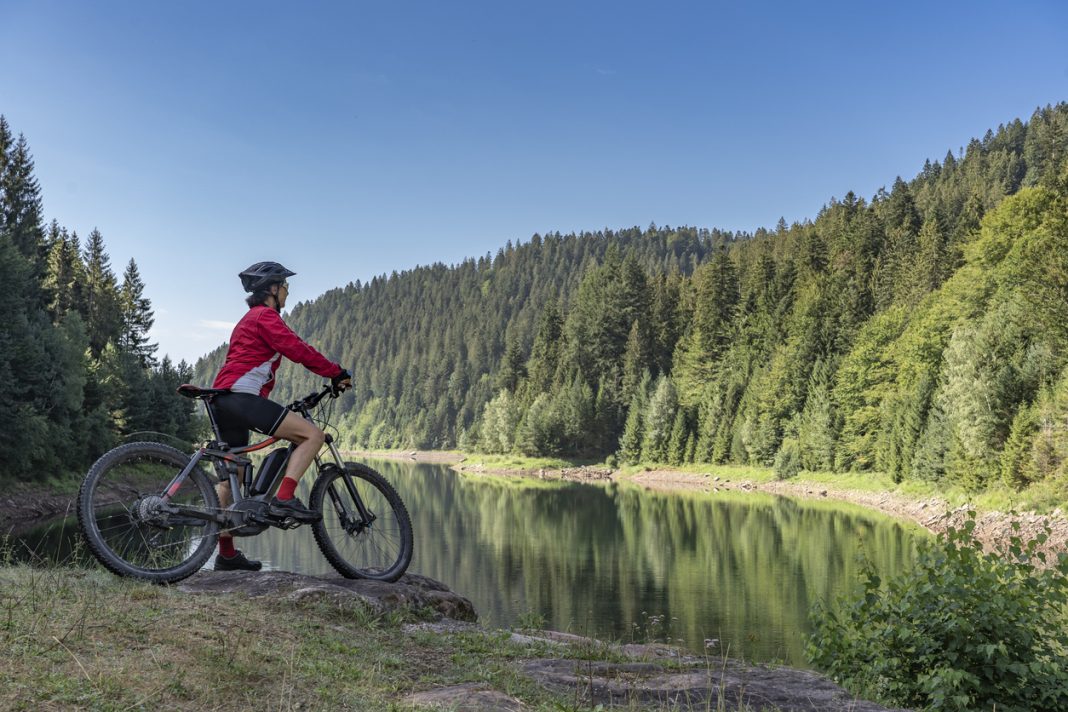Mountain biking isn’t a sport for the lazy. You’re going to need to be active and go on multiple off-road biking trips to get halfway decent at mountain biking. However, it can be one of the most rewarding hobbies, both physically and mentally.
Mountain biking can lead you to some extravagant views, meet new people, and challenge yourself like never before. Off-road biking is fun and engaging and there is always another trail to ride. People plan entire vacations around mountain biking destinations and we think you will too once you get the hang of it!
Here are the four mountain biking basics.
- Preparing Yourself
- Mountain Biking Basic Riding Positions
- Equipment Needed
- Off-Road Biking Needs Practice
This article contains affiliate links, however, that does not effect our research.
Preparing Yourself
In order to get started, you need to be proficient at riding a bike. Before hitting any trails ride your bicycle multiple times a week for extended periods of time. This will build up your endurance, and help you get more familiar with riding.
For those who ride quite often, you can jump to the research phase. Start looking for people who are already proficient mountain biking riders. Join clubs on Facebook or look for some on Meetup. Ask local riders about beginning trails and if you can tag along.
If you’d rather ride with just you and your significant other then do heavy planning. Know exactly the length of the trail, the difficulty level of the trail, and wildlife in the area.
Mountain Biking Basic Riding Positions
One of the important things is to understand about off-road biking is that you need to stay loose, use your momentum, and be prepared to fall. Riding positions are very important in order for you to have a good ride as Sacred Rides points out:
“The proper body position while riding can make or break your ride. After reading the trail, adjusting your weight is an important skill to ensure you don’t keel over the handlebars and you can tackle obstacles confidently.”
You can really only learn the reflex and skill needed for mountain biking by practicing. Enlist the help of a veteran to work on technique. Consider these 5 Key Rider Mistakes that most people make and see if you can stop doing them:
Equipment needed
As with any hobby, mountain biking has its own set of tools and tricks of the trade. Whenever you set out on a trail in an isolated area you don’t want to be without the proper tools. As Selene Yeager points out on Bicycling.com
“There aren’t many convenience stores in the forest or desert. Mountain bike rides will often take considerably longer than you anticipate, as you often run into rugged terrain, have a mechanical, or just get lost. Always pack more food and water than you think you need. Similarly, it’s sometimes impossible for someone to come pick you up if something goes wrong. You may not have cell service even if they could. Always carry the tools you need: a spare tube (or two), pump, and multi-tool. You’ll be more relaxed and have more fun with the peace of mind knowing you have everything you need.”
Gear you’ll need to try in person:
- Bike
- Helmet
Both a bike and helmet will feel different to each and every rider. Before selecting a product in either category make sure to test them in-store. Mountain bikes are also expensive, so do your research. Ask questions like:
- How durable is the bike?
- How much maintenance will I need to perform on this bike?
- Is this a well-known brand?
- What do most first-time buyers purchase?
A helmet is going to protect you when you fall. You will fall. It’s just a fact of the sport, however, getting the proper gear can help protect you from major injuries. Make sure a helmet fits properly and it feels secure on you. While not as expensive, a proper biking helmet can cost over a $100 so keep that in mind.
Gear you can buy online:
JBM Adult BMX Bike Knee Pads and Elbow Pads with Wrist Guards Protective Gear Set: As stated above, you’re going to fall at some point. Elbow and knee padding can be the difference between a broken arm and a lightly bruised one.
CamelBak Podium Dirt Series Chill Insulated Mountain Bike Water Bottle 21 oz, Black: Always bring water when out on the trail. You don’t want to get dehydrated. No matter how short the trail is, water is always a necessity.
Arvano Mountain Bike Backpack Cycling Backpack: A lightweight backpack is necessary to carry tools, cell phones, protein bars, and other items. It’s the best way to carry items for emergency situations or rest times.
JBL Clip 3: Who doesn’t want to listen to music while pushing themselves? Music is fun to have in the background wall riding. However, it serves a more practical level. Oftentimes, you’re going to be surrounded by wildlife and other people. Make some noise to let critters know you are coming and scare off any animals that may be in your path. Also, it’s great way to let others know you coming down the trail.
Off-Road Biking Needs Practice
Finally, you need practice to hone your skills as a rider. Mountain biking basics can’t be learned if you never get out there! Invite friends or join groups to push yourself out of your comfort zone. Remember that every expert started out just where you are.
Most of all, be courteous to others on your trail and have fun!
If you like outdoor content, check out our other guide to camping and best places to go fishing in Texas. Subscribe to Dock Line Magazine and receive free content like this right in your email!















